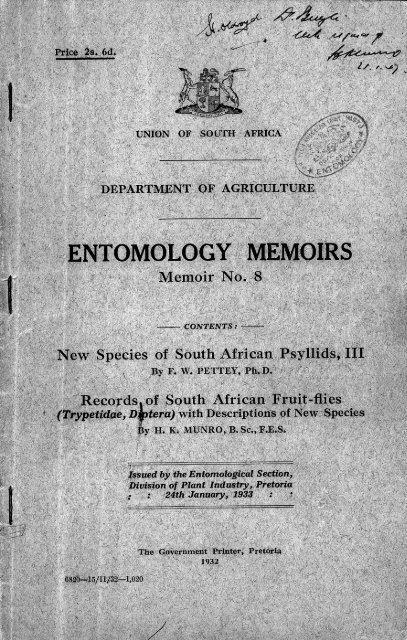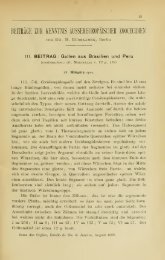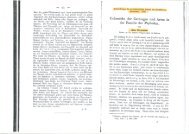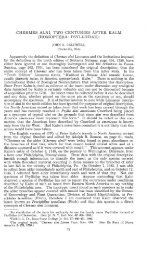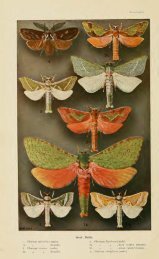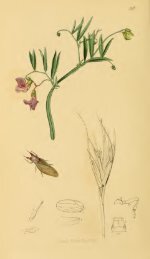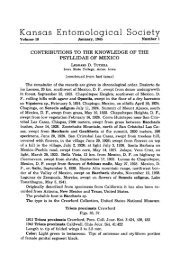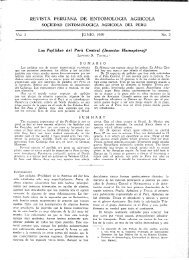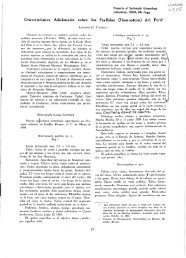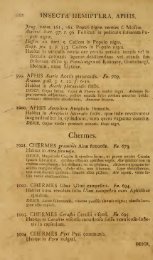ENTOMOLOGY MEMOIRS
ENTOMOLOGY MEMOIRS
ENTOMOLOGY MEMOIRS
You also want an ePaper? Increase the reach of your titles
YUMPU automatically turns print PDFs into web optimized ePapers that Google loves.
Price 2s. 6d.<br />
UNION OF SOUTH AFRICA<br />
DEPARTMENT OF AGRICULTURE<br />
<strong>ENTOMOLOGY</strong> <strong>MEMOIRS</strong><br />
Memoir No. 8<br />
CONTENTS:<br />
New Species of South African Psyllids III<br />
By F. W. PETTEY, Ph. D.<br />
Records of South African Fruit-flies<br />
(Trypetidae, D tera) with Descriptions of New Species<br />
By H. K. MUNRO, B. Sc. F.E.S.<br />
Issued by the Entomological Section,<br />
Division of Plant Industry, Pretoria<br />
24th January, 1933<br />
The Government Printer ,<br />
1932<br />
Pretoria<br />
6820-15/11/32-1,020
NEW SPECIES OF SOUTH<br />
PSYLLIDS III.*<br />
By F. W. PETTEY, Ph.D., Senior Entomologist,<br />
Division of Plant Industry.<br />
AFRICAN<br />
THIS article contains descriptions of new species of Psyllidae collected<br />
by the writer. The types and paratypes may be found in the collection<br />
of the Division of Plant Industry, Entomology Section.<br />
Lsco.,..444....s.<br />
Psylla distincta, sp. nov.<br />
[Pl. I, figs. 1, 2, 21 (a) (b), 24; Pl. II, figs. 39, 40.]<br />
General colour of specimens in alcohol pale yellow, with posterior<br />
margin of vertex, anterior margin of pronotum, entire margin of<br />
praescutum brownish, eyes dark brown. One specimen of the ten<br />
examined has a brownish head and thorax with the posterior margin<br />
of the vertex, the whole of the pronotum, the margin of the praescutum<br />
and of the scutellum, and the tip of the genitalia dark brown.<br />
The male is similar to the female in colour.<br />
Head : Considerably deflexed, including eyes, broader than<br />
praescutorn but not quite as broad as scutellum. Vertex in dried<br />
specimens almost twice as wide as long, with a shallow, distinct<br />
somewhat quadrate fovea on the middle line of each half posterior to<br />
the centre of each half, not pubescent or if so very finely pubescent,<br />
posterior border distinctly emarcdnate, with the anterior border near<br />
the middle suture somewhat bulging in dried specimens; genal cones<br />
almost as long as vertex, divergent, subacute, coarsely pubescent,<br />
the conspicuous setae not very numerous. Antennae long and slender,<br />
the basal seven segments as long as or somewhat longer than the<br />
hood and thorax combined and longer than twice the width of the<br />
head, the third segment longest, the fourth about two-thirds as long<br />
04 the third, the three terminal segments missing in the specimens<br />
available for inspection.<br />
Thorax : Strongly arched, with no or very minute pubescence.<br />
Logs slender ; hind tibia very nearly as long as femur, with a small<br />
1)114111 spur (easily visible in a balsam mount, but not easily visible<br />
w Mt binoculars), and with five rather stout dark brown spines on the<br />
nm,rgin.at the apex two of which are more close together than the<br />
other ; basal segment of the hind tarsi with two spines at the apex;<br />
motto:mail spurs not very large, conical. Fore-wings large, hyaline,<br />
ntosl hree times longer than wide; pterostigma present, somewhat<br />
opal ne, long; veins hairless, marginal cells fairly large, the first<br />
IsinTs, —This article is designated as New Species of South. African Psyllids<br />
I I I New South African Psyllids II may be found in The South African<br />
1)11111111 of Natural History V, 195, pp. 125-142, Pl. XII, XIII. South African<br />
I may be found in Entomological Memoirs No. 2, Department of<br />
Altripulinro, Union of South Africa, 1924, pp. 21-30, P1. I, II, III.
somewhat longer than the second, R + M+ Cu not quite straight, the<br />
claval suture almost attaininu the tip of Cu 2, venation as in figure<br />
la. Hind-wings large, about one-third shorter than the fore-wings;<br />
hyaline; venation as in figure lb. Male genatalia pubescent ; forceps<br />
somewhat conical, slightly toothed or chitinous at apex, shorter than<br />
anal valve, which laterally is about twice the width of the forceps,<br />
and tapers somewhat at the apex. Female genitalia a little more<br />
than half the length of the rest of the abdomen, pubescent ; dorsal<br />
valve rounded at apex, pubescent, with two or three long setae on<br />
each side; ventral valve pubescent, slightly shorter than the dorsal<br />
valve and pointed at the apex,<br />
Measurements : Length of body, male 2 mm. ; female 2.8 mm.<br />
Width of head including eyes, male .6 ram. ; female .7 mm. Length<br />
of fore-wing, male 2.9 mm. ; female 3.11 mm. Width of fore-wing,<br />
male 1 mm.; female 1.12 mm. Length of hind-wing, male 2.02 ram. ;<br />
female 2.03 mm. Width of hind-wing, male .8 mm.; female .81 mm.<br />
Locality and collector doubtful, but probably collected by the<br />
writer by sweeping veld bushes in the western district of the Cape<br />
Province, 1923. Described from two males and two females.<br />
Paurocephala hottentotti, sp. nov.<br />
[Pl. I, figs. 3, 4, 22 (a) (b) (a); Pl. II, figs. 41, 42, 43.]<br />
Colour of dried specimens : Yellow, except the two apical segments<br />
of the antennae, the apical spines of the posterior tibiae and<br />
spines of the basal posterior tarsi, which are dark brown to black,<br />
and the apex of the female genitalia, which is brownish. Ocelli<br />
reddish, eyes, dark brown.<br />
Head of female, including the eyes, about as broad as widest<br />
part of thorax, and almost three times wider than the length of the<br />
median line of the vertex. Vertex flat, wider than long, almost<br />
quadrate, with a shallow fovea in each half near the middle and near<br />
the posterior margin, finely pubescent, posterior margin deeply<br />
emarginate, on the same plane as genae, somewhat deflexed. Genae<br />
finely pubescent, with one or two longer setae located ventrally on<br />
each, somewhat swollen, rounded downwards, and retracted towards<br />
the thorax. Frons visible ventrally, somewhat depressed between<br />
the genae, with anterior ocellus at the apex on the same level as the<br />
vertex and just visible when the vertex is viewed dorsally. Antennae<br />
shorter than length of head and thorax, and somewhat longer than<br />
the width of the head including the eyes, slender, the tenth segment<br />
shorter and narrower than the ninth, and with two apical spines, the<br />
one slightly shorter and stouter than the other and less pointed at<br />
the tip, the third segment about as long as the 4th to the 7th inclusive.<br />
Eyes large, somewhat recessive.<br />
Thorax : Fairly thick dorso-ventrally, fairly well arched, more<br />
finely pubescent than head, two very small circular foveae, one on<br />
each side of the pronotuna, posterior to the eyes ; posterior lateral<br />
angles of the praescutum not prominent, middle line of scutum not<br />
distinct; propleurites rather lonff. Legs comparatively slender, hind<br />
tibiae without basal spur, with six stout black spines at the apex,<br />
three on the inner and three on the outer margin ; metacoxal spurs<br />
rather small, conical, not very slender.<br />
4<br />
5<br />
Fore-wings comparatively long, narrow, rounded at the apex,<br />
widest some distance before the apex, hyaline. All veins and margin<br />
of wing with two rows of minute hairs visible only with high power<br />
of microscope ; pterostigma long and narrow with scattered equally<br />
minute hairs; R, M + Cu, Cu and R + M + Cu sub-equal and rather<br />
long. Hind-wings : Venation as figured, vein Car, wanting in the<br />
specimens examined.<br />
Measurements : Length of body, male 1.35 mm , female 2 ram. ;<br />
length of fore-wing, male 1.45 mm., female 2 mm.; width of forenaale<br />
.65 mm , female .8 ram.; length of hind-wing, male<br />
1.35'' mm., female 1.7 mm. ; width of hind-wing, male .5 mm., female<br />
.6 mm ; width of head, male .5 mm , female .64 mm ; length of<br />
antennae, male .75 mm., female .75 mm.<br />
This species resembles Paurocephala bicarinata Pettey with<br />
respect to the wing venation of the fore-wings and to the male genetalia.<br />
In other respects, however, it differs considerably from the<br />
latter.<br />
Collected on Brabeum, stellatifolium (Hottentots' almond), at<br />
Jonkershoek, Stellenbosch, Cape Province, 20th December, 1922.<br />
It causes galls on the leaves of this shrub. Described from three<br />
males and three females.<br />
Arytaina karrooensis sp. nov.<br />
[Pl. I, figs. 5, 6, 23 (a) (b); Pl. II, figs. 44, 45 (a) OM<br />
Colour (specimens in alcohol) : Head, pronotum except sides,<br />
including the two foveae, praescutum except lateral margin,<br />
scutellirra, legs and abdomen yellowish. Eyes, lateral margins of<br />
pronotum anddb praescaturn and metathorax brownish, metacoxal spurs<br />
pale yellow. Scutum brown, with a broad median longitudinal<br />
yellow stripe and two narrow lateral longitudinal yellow stripes on<br />
each side. Antennae pale yellow, except the two basal and two apical<br />
segments, which are brown, the third to the eighth segments inclusive<br />
dark brown at the apex.<br />
Head (specimens in alcohol), including eyes about as broad as<br />
widest part of thorax, somewhat deflexed, thorax somewhat but not<br />
highly arched. Vertex flat, about one-third wider than the length<br />
of the median line, lateral margins straight between the eyes,<br />
narrower anteriorly, posterior margin emarginate, finely pubescent,<br />
with two small inconspicuous circular foveae on each side of the<br />
median line; genae produced into short, broadly conical processes,<br />
which are as wide as long, coarsely pubescent, each with one very<br />
long ventrally located seta. Eyes comparatively small, slightly<br />
recessive, posterior ocelli bordering posterior margin. Antennae<br />
slender, considerably longer than head and thorax combined, the<br />
last two segments (9th and 10th) practically as slender as the preceding<br />
ones, at least three times longer than wide, the two combined<br />
longer than the eighth. The tenth segment one spine, but possibly<br />
a second may have been broken off (only one antenna available for<br />
examination).<br />
Thorax broad, arched, finely pubescent. Pronotum about half<br />
the length of the vertex, with two circular foveae on each side, the<br />
innermost ones posterior to the ocelli and considerably smaller than
6<br />
the outer ones ; praescutum with long, acute angles at the anterior<br />
lateral margin when viewed dorsally. Legs : Hind tibiae with small<br />
yellowish rather blunt spur at the base, visible with low power of<br />
binocular, and with four dark brown spines at the apex, three on<br />
the inner margin and one on the outer; metacoxal spurs of medium ,<br />
size, acutely conical at tip.<br />
Fore-wings hyaline, rather wide and short, outer margin well<br />
rounded, outer third maculated with brownish more dense maculae<br />
distributed as figured; pterostigma long, with scattered minute hairs.<br />
Costal margin of wing with small hairs ; outer and inner margin<br />
with hairs invisible except with high power of microscope, and then<br />
seen with difficulty; veins with double row of fairly conspicuous<br />
hairs, visible with high power of binoculars; first marginal cell much<br />
longer and wider than the second; R, M + Cu considerably longer<br />
than R, and more than twice as long as M + Cu. Venation of hindwing<br />
as illustrated.<br />
Abdomen fairly coarsely but sparsely pubescent. Female<br />
genitalia : Coarely pubescent, with several long lateral setae on the<br />
dorsal valve before the apex, and with several somewhat shorter setae<br />
on the ventral valve before the apex, which are longer than the other<br />
setae on the ventral valve. Ventral valve, viewed laterally, shorter<br />
and wider and more pointed at the apex than the dorsal valve.<br />
Measurements : Female, length of body 2.2 mm. ; length of forewing<br />
2.25 mm. ; width 1 mm ; length of hind-wing 2 mm. ; width<br />
.85 mm.<br />
Collected on Acacia karroo at De Dooms, Cape Province, 5th<br />
of February, 1923 ; at an elevation of about 2,000 feet. Described<br />
from one female and one male.<br />
Arytaina capensis sp. nov.<br />
[P1. I, figs. 7, 8 ; Pl. II, figs. 30 (a) (b) (a), 46, 47, 48.]<br />
Colour of dry specimens : Abdomen and legs yellowish and<br />
genitalia greenish. Vertex, genae, three basal segments of the<br />
antennae, and basal half of the other antennal segments, except the<br />
tenth, pale yellow, apical half of fourth to tenth antennal segments<br />
black or brown, tenth segment black. Eyes dark brown, ocelli reddish.<br />
Pronotum yellowish with foveae brownish, anterior margin of<br />
praescutum brownish with median stripe and lateral angles yellow,<br />
scutum brownish with two lateral black lines in some specimens on<br />
each side of middle, extending forward from the posterior margin<br />
but not attaining the anterior margin and widest near the posterior<br />
margin, scutellum of metathorax greenish in some specimens. Metacoxal<br />
spurs whitish. Genitalia of male and of female greenish<br />
female genitalia brown at apex.<br />
Head, including eyes, as broad as widest part of thorax, somewhat<br />
dellexed, thorax somewhat but not highly arched. Vertex (in<br />
dried specimens) almost flat, somewhat wider than long and narrower<br />
anteriorly than posteriorly, with a small circular fovea near the<br />
centre and posterior margin of each half extending towards the<br />
anterior, forming a narrow linear groove, very finely pubescent,<br />
posterior margin deeply emarginate, genae produced into subconical<br />
ol gent processes extending in same plane with vertex but<br />
He im raged from the vertex by an impressed line, rounded at apex,<br />
coarsely pubescent, about half as long as vertex. Eyes large, slightly<br />
recessive. Antennae moderately long, slender, extending back farther<br />
than the posterior margin of the tlTorax, the third segment about as<br />
long as the fourth and fifth combined, the fourth to seventh inclusive<br />
sub-equal in length, and longer than the eighth, the ninth and tenth<br />
shorter and broader than the third to the eighth and together about<br />
eil nal in length to the eighth ; two stout setae at the tip of the tenth<br />
segment, the one somewhat stouter and shorter than the other.<br />
Thorax broad, arched, finely pubescent. Pronotum with two<br />
cider foveae on each side, the innermost almost directly posterior<br />
to the ocelli. Legs fairly long; hind tibiae with a very small<br />
yellowish spur at the base, just visible with high power of binoculars,<br />
and with about ten dark brown spines at the apex; basal tarsal segment<br />
with two dark brown spines at the apex; metacoxal spurs rather<br />
long, conical.<br />
Fore-wings hyaline, brownish in the area bordering vein Cu„<br />
with a very long, narrow, opaque or subcoriaceous pterostigmai, which<br />
is pubescent on the costal margin; veins with double row of fine<br />
setae, venation as figured. Hind-wings as figured.<br />
Abdomen coarsely pubescent. Male genitalia pubescent ; forceps<br />
shorter than anal valve, finger-like ; anal valve much wider than<br />
'forceps, converging greatly towards the apex, lateral aspect as<br />
figured. Female genitalia as long as rest of abdomen, pubescent_;<br />
dorsal valve subacute at apex, longer than the ventral, valve, which<br />
is more pointed at apex.<br />
Measurements; Length of body, male 2.3 mm.; female 2.7 mm.<br />
Width of head including eyes, male .7 mm. ; female .75 mm Length<br />
,<br />
of fore-wing, male 2.75 ram. ; female 3.4 mm. Width of fore-wing,<br />
male .95 mm. ; female 1.1 mm. ; length of hind-wing, male 2.2 mm.<br />
female 2.35 mm. Width of hind-wing, male .72 mm. ; female .8 mm.<br />
Collected on Rhus sp. at Waterfall, Groot Drakenstein, Cape<br />
Province, December, 1922. Described from two males and five<br />
females.<br />
Euphalerus valens sp. nov.<br />
[Pl. I, figs. 9, 10, 29; Pl. II, figs. 31 (a) (b), 49, 54, 55.]<br />
Colour of dried specimens : Vertex of head, pronotum, praescutum<br />
and scutum of thorax, and genitalia yellowish brown. Genae,<br />
abdomen, legs and whole ventral surface of body, including head, pale<br />
yellow to white. Eyes, anterior and lateral margins of scutellum,<br />
pox of female genitalia, apex of forceps, spines of hind legs dark<br />
brown, to black. Ocelli reddish orange. The scutum is indistinctly<br />
rked with two broad, broken, brown lines.<br />
Head (dried specimens) of female, including the eyes, distinctly<br />
narrower than the thorax and about three times wider than the<br />
'Novi 11 of the median line of the vertex, considerably deflexed.<br />
Vertex punctate, rather flat, but somewhat swollen on each side of<br />
the median line, subquadrate, the sides straight between the eyes,<br />
converging to front, truncate at front margin, broader than long,
9<br />
with two linear foveae, the deepest part of which is circular and<br />
near the posterior margin, posterior margin emarginate, on the same<br />
plane as genae, coarsely pubescent. Genae coarsely pubesc ent, short,<br />
about as wide as long, conical or subacute at apex. Clypeus small.<br />
Antennae slender, short, about as long as width of head, the three<br />
terminal segments black to brown, wider than the others except the<br />
two basal, the tenth segment shorter and narrower than the ninth<br />
and with two terminal unequal spines, the third segment about, as<br />
long as the fourth to the seventh inclusive.<br />
Thorax: Stout, very convex transversely and longitudinally,<br />
punctate; propleurites rather long, the episternum distinctly swollen;<br />
pronotum and praescutum coarsely pubescent, the pronotum swollen<br />
at lateral margin in form of a knob; scutum more finely pubescent,<br />
very broad and convex. Legs slender, hind tibiae without basal spur,<br />
with about ten stout black spines at apex; metacoxal spurs slender,<br />
conical, not very large.<br />
Wings : Fore-wings not very long, rounded apically, subopaque,<br />
with two transverse bands near the apex, one of which is dark brown<br />
and the other white; two similar transverse bands at the base of the<br />
wing. Pterostigma present, rather narrow, long, with scattered<br />
small hairs. All veins and margin of wing have two rows of small<br />
hairs sufficiently large to be visible through the binocular ,• first<br />
marginal cell distinctly shorter and wider than the second. ifindwings,<br />
venation as figured, Cu, wanting, Cu does not join M.<br />
Genitalia : Female genital segment a little longer than rest of<br />
abdomen, dorsal valve slightly longer and less pointed than the<br />
ventral, coarsely pubescent, with three or four lateral, long setae<br />
before the apex; ventral valve coarsely pubescent. Male genitalia;<br />
forceps a little longer than anal valve, shaped more or less like a<br />
knife blade, long and narrow, narrower apically than basally,<br />
coarsely pubescent, but with shorter setae than the anal valve; anal<br />
valve coarsely pubescent, with setae longest on posterior margin,<br />
narrower and truncate at the apex, widest in the middle.<br />
Measurements : Female, length of body 2.2 mm. ; length of forewing<br />
2.3 mm.; width 1.1 mm. ; length of hind-wing 1 85 mm ; width<br />
.8 mm ; width of head, including eyes, .7 mm.; length of antennae<br />
.7 mm.<br />
This species has been placed in the genus Euphalerus Schwarz<br />
rather than in Diaphorina Lw. because the thorax is strongly arched,<br />
as the tegminae are more rounded and less linear than those included<br />
in the latter genus. The head, although not quite so approaching<br />
to the vertical as other representatives of Euphalerus, is more<br />
depressed than most species included in Diaphorina Lw.<br />
Described from two males and two females collected on the tree<br />
Gymnosporia laurina on Mitchell's Pass, Cape Province, at an altitude<br />
of about 1,000 feet, 20th January, 1923.<br />
Diaphorina quadramaculata sp. nov.<br />
{Pl. I, figs. 11, 12, 26; Pl. II, figs. 32 (a) (b), 50, 51.]<br />
Colour of dried specimens : Head yellowish, ocelli reddish, eyes<br />
dark brown. Pronotum yellowish, praescutum yellowish, with two<br />
large subconical dark brown areas in the centre of the anterior<br />
scutum yellowish with two wide, brown, longitudinal stripes,<br />
on each side of the middle, each brown stripe divided in the<br />
middle by a narrow more or less distinct yellow longitudinal line;<br />
moll ell um and other posterior dorsal segments of the thorax pale<br />
yellow, lateral sclerites dark brown. Dorsal segments of abdomen<br />
mid mita valve of female genitalia dark brown to black, ventral seg-<br />
;limits of abdomen yellowish, ventral segments of female genitalia dark<br />
brow n at apex, yellowish brown at base. Antennae yellowish, except<br />
ihe two terminal segments, which are dark brown. Metathoracic spurs<br />
yellowish at tip, dark brown at base. Legs yellowish, except femora<br />
of middle- and hind-legs, which are brownish. Fore-wings subhyaline,<br />
with IL four distinct dark brown spots located as figured, and with four<br />
nil her indistinct white areas on the inner margin of the' wing, the<br />
largest; at the tip of vein Cu 2, and each of the others more linear (riot<br />
11; tin to) respectively in the centre of the first and second marginal cells,<br />
timl coil M, all on the margin of the wing. The head and thorax are<br />
covered with a white mealy-like secretion.<br />
Head : Somewhat deflexed, punctate, including eyes, somewhat<br />
na rrower than widest part of thorax. Vertex about one and a half<br />
I i mos wider than the length of the middle line, fiat, punctate ; pos-<br />
1 erior border not very deeply emarginate, a small linear fovea in<br />
each half near the middle, the deepest part forming a tiny circle<br />
Iota led posterior to the center, coarsely pubescent. Genae on same<br />
(.‘ el as vertex, directed forward, contiguous for about half their<br />
length, at least a third longer than wide, subconical at tip, coarsely<br />
riled conspicuously pubescent, with setae slightly longer than or about<br />
Ils long as on the vertex. Antennae shorter than width of head,<br />
including eyes, slender, the two terminal segments wider than those<br />
preceding, with two setae at the apex, one at least three times longer<br />
n. nd more pointed than the other ; segments subequal in length, the<br />
third a little longer than the rest, the two last the shortest and<br />
tie idest, the fifth and seventh the narrowest. Eyes slightly recessive,<br />
of medium size.<br />
Thorax somewhat arched, of medium breadth and depth, finely<br />
end distinctly punetate, pubescent, with setae shorter than those on<br />
he head. Pronotum flat, as wide in the middle as at the sides, with<br />
two lateral circular foveae of equal size on each side. Praescutum<br />
nuttely angled at the sides, viewed dorsally, with no evident median<br />
silt iire. Legs of medium size ; hind tibiae with no basal spur, with<br />
n. lrout eight rather long and slender spines (not so thick as those of<br />
I). bi'ovicornis) on the margin at the apex, the posterior margin at<br />
I ho apex free of spines; basal segment of hind tarsi with two stout<br />
spines ; about two and one-third times longer than wide, rounded at<br />
n pox, not as narrow at the base as most species of this genus ; first<br />
marginal cell distinctly shorter and wider than the second; stem R<br />
IL bout twice as long as, and M + Cu a little longer than, R+ M + Cu;<br />
pl erns; igina long, narrow, finely pubescent. 6Veins with two rows<br />
()I' l.ur.irs visible with high power of binocular ; one row of hairs on<br />
1he ;ulterior margin extending slightly beyond the tip of Rs. Four<br />
Mirk brown spots, each at or near the forkin g veins as illustrated<br />
in figure. Venation of hind-wing as figured.<br />
Abdomen sparsely and finely pubescent. Female genitalia :<br />
Over Ralf the length of but not as long as the rest of the abdomen;<br />
beth valves subequal in length, about equally coarsely pubescent_
10<br />
Male genitalia. : Anal valve more than twice as lona. as the forceps,<br />
apical halfattenuated and no more than one-quarter thewidth of the<br />
basal half ; forceps comparatively short, finger-shaped; forceps and<br />
anal valve with short setae.<br />
Measurements.—Female : Length of body 2.45 mm.; length of<br />
fore-wing 2.3 mm., width .9 mm ; length of hind-wing 2.2 mm<br />
width .75 mm ; width of head, plus eyes, .65 mm.; length of antennae<br />
.4 mm Male : Length of body 1.95 mm ; length of fore-wing 2.15<br />
mm., width .88 mm ; length of hind-wing 1.9 mm., width .68 mm.;<br />
width of head .5 mm<br />
Described from two males and four females collected at Osplaats,<br />
Cape Province on Euryops lateriflorus Less. at an elevation of about<br />
2,500 feet in roo kar area , 3rd February 1923.<br />
This species resembles Diaphorina punctulata Pettey with<br />
respect to the head and genitalia, but is distinctly different with<br />
respect to the shape and maculation of the fore-wings.<br />
Diaphorina euryopsi sp. nov.<br />
[Pl. I, figs. 13, 14, 27; Pl. II, figs. 33 (a) (b), 56, 60.;<br />
General colour of female (dried specimens) : Head, and ventral<br />
part of abdomen pale yellow, thorax and dorsal part of abdomen, eyes<br />
and femora of legs mostly dark brown. Vertex and genae pale<br />
yellow, ocelli reddish orange, antennae pale yellow except the three<br />
terminal segments which are dark brown. Pronotum pale yellow,<br />
with the inner foveae brownish and the outer foveae dark brown.<br />
Praescutum yellowish with lateral acute angles brownish and with<br />
two large broadly cone-shaped dark brown areas bordering the<br />
anterior margin, one on each side of the middle and extending posteriorly<br />
beyond the middle. Scutum dark brown, with a broad<br />
median longitudinal yellowish stripe and two narrow yellowish brown<br />
lateral stripes, one on each side of the middle, not straight, but<br />
somewhat curved, and extending through the inner third of the dark<br />
brown area. Scutellum yellowish. Remaining dorsal thoracic segments<br />
yellowish brown, with dark brown areas laterally. Rest of<br />
thorax orange coloured and black laterally, and dark brown to black<br />
ventrally. Femora and basal third of tibiae dark brown to black,<br />
the rest of legs pale yellow; metacoxal spurs pale yellow, black<br />
at base. Dorsal segments of abdomen mostly black laterally and<br />
pale yellow dorsally; venter pale yellow with two more or less distinct<br />
yellowish orange irregular longitudinal stripes, one on each<br />
side of the middle. Genitalia dark brown to black; anus reddish<br />
orange. Colour of male similar, but anus not reddish orange.<br />
Head : Somewhat but not greatly deflexed, punctate, including<br />
eyes, slightly narrower than widest part of thorax. Vertex a little<br />
more than one and a half times wider than the length of the middle<br />
line, fiat, punctate, posterior border not very deeply emarginate, a<br />
small circular fovea in each half near the middle posterior to the<br />
center, and a more or less distinct, minute puncture posterior to each<br />
fovea, coarsely pubescent. Genae on same level as vertex, directed<br />
forward, contiguous at and near the base, a little lonffer than wide<br />
but less than one-third lonffer, subconical at tip, coarsely pubescent,<br />
with setae slightly longer than on the vertex, no longer than or some-<br />
11<br />
+dull shorter than the vertex. Antennae shorter than width of head,<br />
m1.111111 ii eyes, slender, the three terminal segments wider than the<br />
',welling, with two short unequal spines at the apex, segments subnu<br />
I i n length, the third a little longer than the rest, the fifth and<br />
limpid!) the narrowest.<br />
Thorax somewhat arched, of medium breadth and depth, finely<br />
Int e,pubescent, with setae shorter than those on the head.<br />
Pronot um flat as wide in the middle as at the sides, with two lateral<br />
circular foveae on each side, the innermost ones smaller than the<br />
outermost. Praescutum acutely angled at the sides, viewed dorsally,<br />
1,11 no median dorsal suture, with two distinct short angles, one , on<br />
each side of the posterior margin. Legs : Of medium size ; hind<br />
bine with no basal spur, with about seven stout, black spines on<br />
Die margin at the apex, three visible on one side and four on the<br />
other, the posterior margin at the apex free of spines; metacoxal<br />
spurs of medium size, acutely conical.<br />
Vero-wings : About two and a quarter times' longer than wide,<br />
roil tided at apex, not as narrow at the base as most species •of this<br />
ge111114, similar in shape to those of Diaph, quadramaculata;,r first<br />
irgri nal cell shorter and wider than the second; stem R a little<br />
ltalgot, and M+ Cu one-third shorter than stem R + Cu<br />
%•e] M highly arched near forking of MI 2 + and M3+4; pteroi<br />
gem long, narrow, finely pubescent. Veins with two rows of hairs<br />
hie with difficulty with high power of microcope because of the<br />
taihopaque nature of the wing; one row of hairs on the anterior<br />
i n, terminating before the tip of Rs; no distinct maculae.<br />
Abdomen finely pubescent,. Female genitalia : Over half the<br />
-hwl h of but not as long as the rest of the abdomen; ventral valve<br />
II litt le shorter than the dorsal valve, finely and densely pubescent;<br />
dorsal 1 valve finely pubescent, with four or five longer setae on each<br />
,ritle before the apex. Male genitalia : Anal valve nearly as long as<br />
the forceps, apical fourth attenuated, pubescent, setae subequal in<br />
length; forceps slightly wider in the middle that at either end,<br />
pubescent, with long numerous setae on the inner surface, lateral<br />
seine short and subequal.<br />
1111 easurements.—Female : Length of body 2.4 mm.; length of<br />
('ore- w i lig 2.5 mm., width 1 mm. ; length of hind-wing 2.1 mm., width<br />
7;) iiim.; length of antennae .45 mm.; width of had .67 mm. Mate<br />
willow hat smaller than female.<br />
Described from four males and four females collected at Orchard<br />
Sid i lig, Cape Province, on Euryops sp. at an elevation of about 2,000<br />
feet, in Karroo veld, 4th February, 1923.<br />
This species resembles Diaphorina quadramaculata with respect<br />
to the shape of the fore-wings and the head, but it distinctly differs<br />
from I lie latter as follows : The four spots on the wings are wanting,<br />
the n.nul. valve of the male is comparatively much shorter, and the<br />
gentle and vertex are wider and, shorter.<br />
.<br />
Diaphorina multimaculata. sp. nov.<br />
[Pl. I, figs. 15, 28; Pl. II, figs. 34 (a) (b), 52, 53.]<br />
General colour of female (specimens in alcohol): Head pale<br />
flow, thorax pale yellow and brown, dorsuin of abdomen and Beni-
12<br />
talia dark brown, venter pale yellow. Vertex and genae pale yellow,<br />
eyes dark brown, ocelli orange, antennae pale yellow except the two<br />
terminal segments. Colour markings of thorax obscure because of<br />
long storage of specimens in alcohol. The pronotum appears to be<br />
pale yellow. The praescutum pale yellow, with two cone-shaped dark<br />
brown areas bordering the anterior margin, one on each side of the<br />
middle and extending posteriorly to about the center of the<br />
praescutum. Scutum pale yellow with two brown longitudinal stripes<br />
on each side of the middle, the innermost of which are narrowly oval<br />
in shape, the narrowest end nearest the anterior margin, the outermost<br />
stripes widest at the posterior margin. Lateral sclerites of<br />
thorax brownish, sutures dark brown. Femora of legs brownish,<br />
tibiae and tarsi pale yellow, spines dark brown. Venter of<br />
abdomen pale yellow, with two distinct dark brown longitudinal<br />
narrow stripes, one on each side of the middle, extending through<br />
the second, third and fourth segments, each stripe broken before<br />
reaching the posterior margin of each of these segments. Colour of<br />
male similar.<br />
Head somewhat but not greatly deflexed, punctate; including<br />
eyes somewhat narrower than the broadest part of thorax. Vertex<br />
about twice as wide as the length of the middle line, rather deeply<br />
emarginate at the posterior margin, a deep circular fovea on each<br />
side near the posterior margin and near the middle of each half, a<br />
shallow depression extending forward from the fovea towards the<br />
middle line but not attaining it; coarsely pubescent. Genae on the<br />
same level as the vertex, contiguous at or near the base, about as<br />
wide as long, somewhat shorter than the vertex, diverging outwards<br />
slightly, a little more coarsely pubesCent than the vertex. Antennae<br />
shorter than width of head, including eyes, slender, the three terminal<br />
segments wider than the preceding, with two unequal spines at the<br />
apex; segments subequal in length, the third a little longer than the<br />
rest, the fifth and seventh the narrowest, the tenth or terminal one<br />
the shortest.<br />
Thorax somewhat arched, robust, finely punctate, pubescent, the<br />
setae shorter than those of the head. Pronotum flat, viewed dorsally,<br />
of equal width throughout, with two lateral circular foveae on each<br />
side, the inner ones smaller than the outer. Praescutum acutely angled<br />
at the sides, with no median dorsal suture, slightly angled on each<br />
side of the posterior margin. Legs of medium size; hind tibiae without<br />
a basal spur, with about seven not very short, stout black spines<br />
on the margin at the apex, three visible on one side and four on the<br />
other, the posterior margin at the apex free of spines; metacoxal<br />
spurs of medium size, acutely conical.<br />
Fore-wings a little less than two and a half times as long as<br />
wide at widest part, rounded at apex, narrow at base; first marginal<br />
cell shorter than the second, and about twice as wide as the second;<br />
stem 11 about one and a half times as long as 1Z-1-M+ Cu; M+ Cu<br />
about one-third shorter than R+ Al+ Cu; pterostignia long, narrow,<br />
pubescent. Veins with two rows of hairs visible with high power of<br />
binoculars, a row of hairs visible on the costal, outer and inner<br />
margins of the wing. Maculae numerous and scattered, but concentrated<br />
mostly in the outer or apical half of the wing; three areas on<br />
the outer margin of the wing, each respectively near the centre of<br />
13<br />
i he first marginal cell, cell 311, and the second marginal cell are<br />
Pommy hal, more hyaline than the area of the remaining outer margin<br />
id the wing, Venation of hind-wing as figured.<br />
A Women pubescent. Female genitalia, large, somewhat longer<br />
timii the rest of the abdomen; ventral valve shorter than the dorsal<br />
and rather widely separated from the latter at the apex, rather<br />
spa ' ,rally pubescent, with subequal short setae; dorsal valve of the<br />
wend shape, rather sparsely pubescent, with several lateral setae<br />
somewhat longer than the rest. Male genitalia : Anal valve about<br />
ti third longer than the forceps, pubescent, setae subequal in length,<br />
of the usual shape; forceps sha ped as figured, a little narrower at<br />
Ri ■ex and base than the middle, setae on inner surface longer than<br />
tin the outer surface.<br />
M eir,urements.—Female : Length of body 2 ram.; length of forew<br />
i lig 2.4 mm., width .9 mm ; length of hind-wing 2.05 mm., width<br />
.77 lion.; length of antennae .35 mm. Male somewhat smaller than<br />
remelt).<br />
De ,,eribed from three female and four male specimens collected<br />
tai. Kwryops tenuissimus Less. at Osplaats, Cape Province, in Karroo<br />
Yeti] itt an elevation of about 2,500 feet.<br />
This species resembles Diaphorina euryospi with respect to the<br />
rliii iii' and pubescence of the head and thorax, the legs, antennae and<br />
1{1 , 11 i Inlia, but differs from the latter species in the following respects :<br />
'Clio fore-wings have numerous distinct maculae, and the first margi<br />
ini.I cell is comparatively much wider than the second, the vein Al<br />
is less highly arched, the genae are less broadly rounded at the apex<br />
and diverge more outwards, and the praescuturn is less prominently<br />
tingled on the posterior lateral margin.<br />
Diaphorina simi/is sp. nov.<br />
[Pl. I, figs 16, 25; P1. II, figs. 35 (a) (b), 57, 58.]<br />
I ieneral colour of female (dried specimens) obscured in most<br />
ri meinions by the presence of a white mealy-like excretion covering<br />
1 le whole insect, forming on the thorax a longitudinal median dorsal<br />
li it o stripe extending through the pronotum and praescutum. Two<br />
s pee i mons, which have no mealy-like excretion on the boily are<br />
eal(Hil oil as follows :—Vertex, genae and pronotum pale yellow, ocelli<br />
yellowish brown, eyes dark brown, antennae pale yellow except the<br />
t.tt ii tenni aal or ninth and tenth segments, which are dark brown.<br />
lirliesin I um pale yellow with two ''broad, straight, orange-brown,<br />
longit.uilinal stripes, one on each side of the middle, extending from<br />
I he n.nterior margin but not attaining the posterior margin. Scutum<br />
tul le yellow with four longitudinal brown stripes, two on each side<br />
of the middle, the outermost of which are triangular shaped, the<br />
1. 1 .0x of which triangle attains the anterior margin of the scutum,<br />
and I he base of which attains the posterior margin. Scutellum pale<br />
yellow. The metathorax is dark brown ventrally, with pale yellow<br />
imitileoxill spurs. The remainder of the thorax and the legs are pale<br />
yellow. Spines on hind tibiae and tarsi dark brown. Venter of<br />
bilonitin pale yellow; dorsal portion mostly dark brown, especially<br />
lid orally, hat more yellowish dorsally except the posterior segment,
i<br />
'<br />
t<br />
14<br />
which is wholly dark brown; • anal valve of genitalia dark brown, with<br />
anal ring yellowish; ventral valve pale yellow except apex, which is<br />
dark brown.<br />
Head somewhat but not greatly defiexed, punctate including<br />
eyes somewhat narrower than broadest part of thorax. Ver tex about<br />
one and a half times wider than the length of the middle line, posterior<br />
margin rather deeply emarginate, two circular foveae on each<br />
side near the posterior margin, and in the middle of each half, a<br />
shallow linear depression extending from the fovea towards the<br />
middle line but not attaining it, coarsely pubescent. Genae on the<br />
same level as the vertex, contiguous at or near the base, distinctly<br />
a little lonuer than wide, diverging outwards slightly, about as<br />
coarsely pubescent as the vertex. Eyes much wider posteriorly than<br />
anteriorly. Antennae slightly longer than half of the width of the<br />
head, including the eyes, slender, the three terminal segments wider<br />
than the preceding, with two short unequal spines at the apex, segments<br />
subequal in length, the third a little longer than the rest, the<br />
fifth and seventh the narrowest, the terminal one the shortest.<br />
Thorax somewhat arched, robust, finely punctate, pubescent, the<br />
setae almost as long as those on the head. Pronotum viewed dorsally<br />
as wide as the middle at the sides, but narrower between the middle<br />
and sides, with two lateral subequal foveae on each side. Praescutum<br />
acutely angled laterally, with no evident median dorsal suture, posterior<br />
margin slightly angled laterally. Legs of medium size; hind<br />
tibiae with no basal spur, with six to eight (generally eight) rather<br />
long stout black spines on the margin at the apex, three visible on<br />
the outer side and four visible on the inner side when viewed<br />
laterally; metacoxal spurs of medium size, acutely conical.<br />
Fore-winc,s practically three times longer than wide at widest<br />
part, rounded at apex, not very narrow at base comparatively; the<br />
first marginal cell shorter and about one and a half times wider than<br />
the second. Stem R a little more than one and a third times longer<br />
than R +M + Cu. M+ Cu a little more than half as long as<br />
R + M + Cu. Pterostigma long, narrow, pubescent. Veins with two<br />
rows of hairs, visible with high power of binoculars. A row of hairs<br />
visible on the costal, outer and inner margins of the wing, more<br />
easily seen on the costal marc,in. Wings more maculated in the<br />
apical third, with three more or less distinct hemispherical or lunulate<br />
hyaline areas, bordering the margin, each respectively in the first<br />
marginal cell, the second marginal cell and cell M.<br />
Abdomen pubescent. Female genitalia a little longer than the<br />
rest of the abdomen; ventral valve a little shorter than the dorsal,<br />
contiguous with the latter at the apex, pubescent, with subequal<br />
short setae; dorsal valve of the usual form, pubescent, with several<br />
lateral setae somewhat longer than the rest. Male genitalia<br />
pubescent; anal valve about a quarter longer than the forceps; forceps<br />
viewed laterally, broadly rounded at apex, basal third somewhat<br />
narrower than the rest ; setae on inner surface longer than the others.<br />
Measurements.—Female : Length of body 2.1 mm.; length of<br />
fore-wing 2.2 mm., width .74 mm.; length of hind-wing 1.95 mm.,<br />
width .62 mm. ' • width of head .55 mm. • length of antennae .35 mm.<br />
Male somewhat smaller than female.<br />
15<br />
Deseribed from three females and five males collected on<br />
wipn tonuissimus Less. at Osplaats, Cape Province, in Karroo<br />
veld. ((tan elevation of about 2,500 feet, 3rd February, 1923.<br />
'I'hiw Hpecies is very similar to Diaphorina multirmaculata but<br />
11(1'11 , 14 from the latter in having a different distribution of maculae<br />
its l fore-wing, a more elongate fore-wing, somewhat longer geime<br />
Anil vertex, and the male has a shorter and stouter anal valve and<br />
Ito OpH, The forceps is narrowly rounded at the apex, while that of<br />
I he bitter is broadly rounded.<br />
Diaphorina brevicornis sp. nova<br />
[Pl. I, figs. 17, 18; Pl. II, figs. 36 (a) (b), 59.]<br />
General colour of female (dry specimens) :—Head yellowish<br />
IP own, thorax brownish with dark brown to black rather indistinct<br />
ni.ril eer( on the praescutum and scutum, dorsum of abdomen blackish,<br />
veil ter brownish, genitalia dark brown with yellowish anus and anal<br />
sag. Vertex brownish with dark brown foveae, genae brownish,<br />
pale yellowish at apex, eyes brown, ocelli dark brown, antennae<br />
yellowish brown with three terminal segments, dark brown, clypeus<br />
black. Pronotum yellowish brown with two lateral brown foveae<br />
ea each side. Praescutum brown, with two broad rather indistinct<br />
Meek longitudinal stripes, blackest anteriorly, the one separated from<br />
the other by a median brown narrow line. praescutura brown with<br />
I s,o !Moral indistinct, black, longitudinal stripes on each side of<br />
the middle, the innermost of which is more or less elliptical in shape.<br />
11,111 ova solerites of thorax brown with dark brown sutures. Femora<br />
a all legs dark brown, basal two-thirds of tibiae of first and second<br />
p et ir of legs dark brown, the apical third and tarsi yellowish; hind<br />
I i bine and tarsi yellow. Venter of abdomen yellowish, with a lateral<br />
rk brown longitudinal narrow stripe on each side of the middle<br />
ex tending through the second, third and fourth segments, broken<br />
beINN eon each segment. Metacoxal spurs pale yellow.<br />
Tread somewhat but not greatly defiexed, finely punctate, ineln,ling<br />
eyes, somewhat narrower than the broadest part of the thorax.<br />
Vertex; excluding the eyes, about twice as wide as the length of the<br />
media n suture, deeply emarginate at the posterior margin, coarsely<br />
p iifieseent, a distinct circular fovea on each side near the posterior<br />
rgin and near the middle of each half, with no shallow linear<br />
depression. Genae on the same level as the vertex, contiguous at or<br />
nea r flie base-, about as wide as long, somewhat shorter than the<br />
vortex, diverging slightly outwards, a little more coarsely pubescent<br />
thou the vertex. Antennae only slightly longer than half the width<br />
he head, including the eyes, slender, the three terminal segments<br />
w for limn the preceding, with two unequal spines at the apex,<br />
segments subequal in length, the fourth a little longer than the rest,<br />
the fifth and seventh the narrowest. Eyes slightly recessive, of<br />
medium size.<br />
Thorax somewhat arched, robust, finely punctate, pubescent, the<br />
mei ite shorter than those of the head. Pronotum flat, viewed dorsally,<br />
of equal width throughout, with two lateral subequal circular foveae<br />
on each side, each about as wide as the lengthy of the pronotum.<br />
Prtteseutum viewed dorsally, acutely angled at the sides, with no
16<br />
median dorsal line, distinctly angled on each side of the posterior<br />
margin. Legs of medium size, hind tibiae Without a basal spur, with<br />
about eight very short stout black spines on the margin at the apex,<br />
four . visible on each , side, the posterior<br />
.<br />
margin at the apex free of<br />
,<br />
spines; metacoxal spurs of medium size, acutely conical.<br />
Fore-wings slightly less than two and a half times as wide as<br />
their widest `part, rounded at apex, narrow at base; first marginal<br />
cell a little shorter and one-quarter wider than the second at the<br />
apex; stem R about one-fifth lonoer than 1Z+ M + Cu; M+ Cu about<br />
one-third the length of It + M + Cu ; pterostigma long, narrow<br />
pubescent. Veins with two rows of hairs visible with high power<br />
of binoculars, a row of hairs visible on the costal, outer and inner<br />
margins of the wing. Maculae numerous and scattered except at<br />
and near the base of the wing, with a large hyaline area near the<br />
apex of cell 11, extending well into cell Rs, and with another large<br />
hyaline area at the apex of cell Cu
18<br />
differs particularly from the latter in having a comparatively<br />
broader and deeper thorax, longer genae, a more depressed head,<br />
wider, more rounded, fore-wings, and longer more prominent setae<br />
on the head and thorax.<br />
Diaphorina fusca sp. nov.<br />
[Pl. I, fig. 20; Pl. II, figs. 38 (a) (b), 63, 64.]<br />
Colour of female (dry specimens) : —Vertex reddish-orange,<br />
genae yellowish, eyes black, clypeus black. Antennae yellowish,<br />
with three terminal segments dark brown. Pronotum reddish-orange<br />
with posterior margin dark brown dorsally. Praescutum reddishorange.<br />
Scutum reddish-orange with two more or less distinct black,<br />
longitudinal stripes on each side of the middle, the innermost some- ,<br />
what narrower than the outermost. Scutellum yellowish. Femora<br />
blackish, tibiae and tarsi pale yellow; metacoxal spurs pale yellow,'<br />
brownish at base. Dorsum of abdomen reddish-orange, venter pale Y4<br />
yellow with broad more or less distinct and continuous broad orange r.<br />
median longitudinal stripe. Genitalia yellowish-brown, black<br />
apex; anal plate reddish-orange.<br />
Head somewhat but not greatly deflexed, distinctly punctate,<br />
including the eyes, slightly narrower than the widest part of the<br />
thorax. Vertex, excluding the eyes, slightly more than twice as wide<br />
as the length of the median suture, at least one-third longer than<br />
the genae, with minute setae visible only, with high power of<br />
binoculars, a fovea in each half surrounded with a shallow not linear<br />
depression located near the posterior margin in the middle of each<br />
half. Genae broadly oval, about as wide as long, contiguous at the<br />
base, finely pubescent, the setae minute. Antennae about as long as<br />
or slightly longer than half the width of the head, including the<br />
eyes, slender, the three terminal seaments thicker than the rest,<br />
with two unequal spines on the tenth or terminal one, all segments<br />
subequal ,the third not longer than the rest, the seventh the narrowest.<br />
Eyes slightly recessive, black, comparatively large, broadly elliptical<br />
viewed anteriorly.<br />
Thorax somewhat but not greatly arched, not very robust, distinctly<br />
punctate, not pubescent. Pronotum fiat, viewed dorsally,<br />
with two circular subequal foveae on each side. Praescutum, viewed<br />
dorsally, acutely angled at the side, with no median line slightly<br />
angular on each side of the posterior margi n . Legs of medi um size ;<br />
hind tibiae without a basal spur, with five to eight stout, not very<br />
short spines on the margin at the apex, the posterior margin at the<br />
apex free of spines ; metacoxal spurs of medium size, slender, acutely<br />
conical.<br />
Fore-wings a little more than twice as long as wide, elliptical,<br />
rounded at apex, not very narrow at base; first marginal cell somewhat<br />
shorter and only slightly wider than the second. Stem R about<br />
one-third longer than R + M+ Cu. M + Cu about one-third shorter<br />
than R +M +Cu; pterostigma long, narrow, not pubescent. No<br />
hairs on veins. Fore-wings fuscous except , cell C + Sc, which is<br />
hyaline, maculated. Cells R„ Rs, M, first and second marginal<br />
cells maculated, the maculae forming, on the whole, large areas, a<br />
more or less hyaline semi-circular spot on the margin of the wing<br />
in cells Rs, M and first and second marginal cells.<br />
19<br />
Abdomen not pubescent. Female genitalia about as long as the<br />
rest of abdomen, or slightly larger, of''normal shape; ventral valve<br />
finely pubescent, the anal valve with longer, but not very numerous<br />
subequal setae. Male genitalia pubescent, the setae subequal in<br />
length ; the anal valve distinctly longer than the forceps, with narrow<br />
apical third, considerably wider near the base.<br />
Measurements : --Length. of body, female 1.55 mm., male 1.1<br />
mm. ; length of fore-wing, female 1.5 mm , male 1.5 mm.; width of<br />
fore-wing, female .6 mm , male .6 mm ; length of antennae, female<br />
.25 mm., male .25 mm.<br />
Described from four females and two males collected by the<br />
writer on Erica mammosa<br />
L. at Viljoen's Pass, Cape Province,<br />
January, 1923, at an elevation of about 2,500 feet.<br />
This species is quite typical of the genus Diaphorina and is distinguished<br />
by the fuscous fore-wings and the comparatively fine setae<br />
on '''the head and absence of setae on thorax. It is different from<br />
most, if not all, other members of this genus in having no hairs on<br />
the veins of the fore-wings.<br />
Spanioza erythreae (Del Guercio).<br />
Boselli, Boll. Lab. Zool., Portici, xxiv, 228 (1930).<br />
Trioza merwei Pettey, S.A. Jul. Nat. Hist., IV, 30 (1923).<br />
This species has been placed in the genus Spanioza Enderlein,<br />
which includes those formerly placed in Trioza having the fore-wings<br />
with Rs straight, or concave anteriorly and terminating in the<br />
anterior margin of the wino., proximad of the forking of M1 + 2 and<br />
M3+4 (Psyllidologia VIII., Ent. Mitt., XV, 1926, nr. 5/6).<br />
It was originally described from Erythrea, North Africa, and<br />
is recorded as a Pest of citrus in Kenya and in South Africa.
21<br />
1. Psylla distin,cta, sp. nov.<br />
2. Psylla distincta, sp. nov.<br />
3. Paurocephala hottentotti, sp. nov.<br />
4. Paurocephala hottentotti, sp. nov.<br />
5. Arytaina karrooensis, sp. nov.<br />
6. Arytain,a karrooensis, sp. nov.<br />
7. Arytaina capensis, sp. nov.<br />
8. Arytaina capensis, sp. nov.<br />
9. Euphalerus valens, sp. nov.<br />
10. Euphalerus valens, sp. nov.<br />
S.A. PSYLLIDAE.<br />
PLATE I.<br />
11. Diaphorina quadrannaculata„ sp. nov.<br />
12. Diaphorina, quadramaculata, sp. nov.<br />
13. Diaphorin,a, euryopsi, sp. nov.<br />
14. Diaphorina euryopsi, sp. nay.<br />
15. Diaphorina multimaculata, sp. nov.<br />
16. Diaphorina similis, sp. nov.<br />
17. Diaphorina brevicornis, sp. nov.<br />
18. Diaphorina brevicornis, sp. nov.<br />
19. Euphalerus ericae, sp. nov.<br />
20. Euphalerus fusca, sp. nov.<br />
21. Psylla distincta, sp. nov. (a) Fore-wing; (b) Hind-wing.<br />
22. Pawrocephala hottentotti, sp. nov. (a) Fore-wing; (b) Hind-wing; (c) Hindleg.<br />
23. Arytaina karrooensis, sp. nov. (a) Fore-wing; (b) Hind-wing.<br />
24. Psylla distincta, sp. nov. Hind-leg; apex of tibia and first segment of<br />
tarsus (inner aspect).<br />
25. Diaphorina brevicornis, sp. nov. Hind-leg; apex of tibia and first segment<br />
of tarsus (outer aspect).<br />
26. Diaphorina quadramaculata, sp. nov. Hind-leg; apex of tibia and first<br />
segment of tarsus (inner aspect).<br />
27. Diaphorina euryopsi, sp. nov. Hind-leg; apex of tibia and first segment<br />
of tarsus (outer aspect).<br />
28. Diaphorina multimaculata. Hind-leg. Apex of tibia and first segment of<br />
tarsus (inner aspect).<br />
29. Euphalerus valens, sp. nov. Hind-leg; apex of tibia and first segment of<br />
tarsus (inner aspect).
it*<br />
..0§gird<br />
via<br />
a<br />
.6<br />
22<br />
=41 vat 41 qtr<br />
PLATE II.<br />
6<br />
(<br />
I<br />
11 . . 1111<br />
ll iI<br />
P ail asp -<br />
23<br />
S.A. PSYLLIDAE.<br />
PLATE II.<br />
30. Arytaina capensis, sp. nov. (a) Fore-wing; (b) Hind-wing; (c) Antenna.<br />
31. Euphalerus valens, sp. nov. (a) Fore-wing; (b) Hind-wing.<br />
32. Diaphorina quadramaculata, sp. nov. (a) Fore-wing; (b) Hind-wing.<br />
33. Diaphorina euryopsi, sp. nov. (a) Fore-wing; (b) Hind-wing.<br />
34. Diaphonna multimaculata, sp. nov. (a) Fore-wing; (b) Hind-wing.<br />
35. Diaphorina similis, sp. nov. (a) Fore-wing; (b) Hind-wing.<br />
36. Diaphorina brevicornis, sp. nov. (a) Fore-wing; (b) Hind-wing.<br />
37. Euphalerus ericae, sp. nov. Fore-wing.<br />
38. Diaphorina fusca, sp. nov. (a) Fore-wing; (b) Hind-wing.<br />
39. Psylla distincta, sp. nov. Female genitalia.<br />
40. Psylla distincta, sp. nov. Male genitalia.<br />
41. Paurocephala hottentotti, sp. nov. Female genitalia.<br />
42. Paurocephala hottentotti, sp. nov. Male genitalia.<br />
43. Paurocephala hottentotti, sp. nov. Terminal segments of antenna (female).<br />
44. Arytaina, karrooensis, sp. nov. Female genitalia.<br />
45. Arytaina karrooensis, sp. nov. (a) Apex of hind-leg of tibia and basal<br />
segment of tarsus; (b) Base of hind tibia and apex of femur.<br />
46. Arytaina capensis, sp. nov. Hind-leg; apex of tibia and basal segment of<br />
tarsus (inner aspect).<br />
47. Arytaina capensis, sp. nov. Male genitalia.<br />
48. Arytaina capensis, sp. nov. Female genitalia.<br />
49. Euphalerus valens, sp. nov. Female genitalia.<br />
50. Diaphorina quadramaculata, sp. nov. Male genitalia<br />
51. Diaphorina quadramaculata, sp. nov. Female genitalia.<br />
52. Diaphorina multimaculata, sp. nov. Female genitalia.<br />
53. Diaphorina multimaculata, sp. nov. Male genitalia.<br />
54. Euphalerus valens, sp. nov. Male genitalia.<br />
55. Euphalerus valens, sp. nova Eight terminal segments of antenna (female )<br />
56. Diaphorina euryopsi, sp. nov. Female genitalia.<br />
57. Diaphorina similis, sp. nov. Male genitalia.<br />
58. Diaphorina similis, sp. nov. Female genitalia.<br />
59. Diaphorin,a, brevicornis, sp. nov. Female genitalia.<br />
60. Diaphorina euryopsi, sp. nov. Male genitalia.<br />
61. Euphalerus ericae, sp. nov. Male genitalia.<br />
62. Euphalerus ericae, sp. nov. Female genitalia.<br />
63. Diaphorina fusca, sp. nov. Female genitalia.<br />
64. Diaphorina fusca, sp. nov. Male genitalia.


